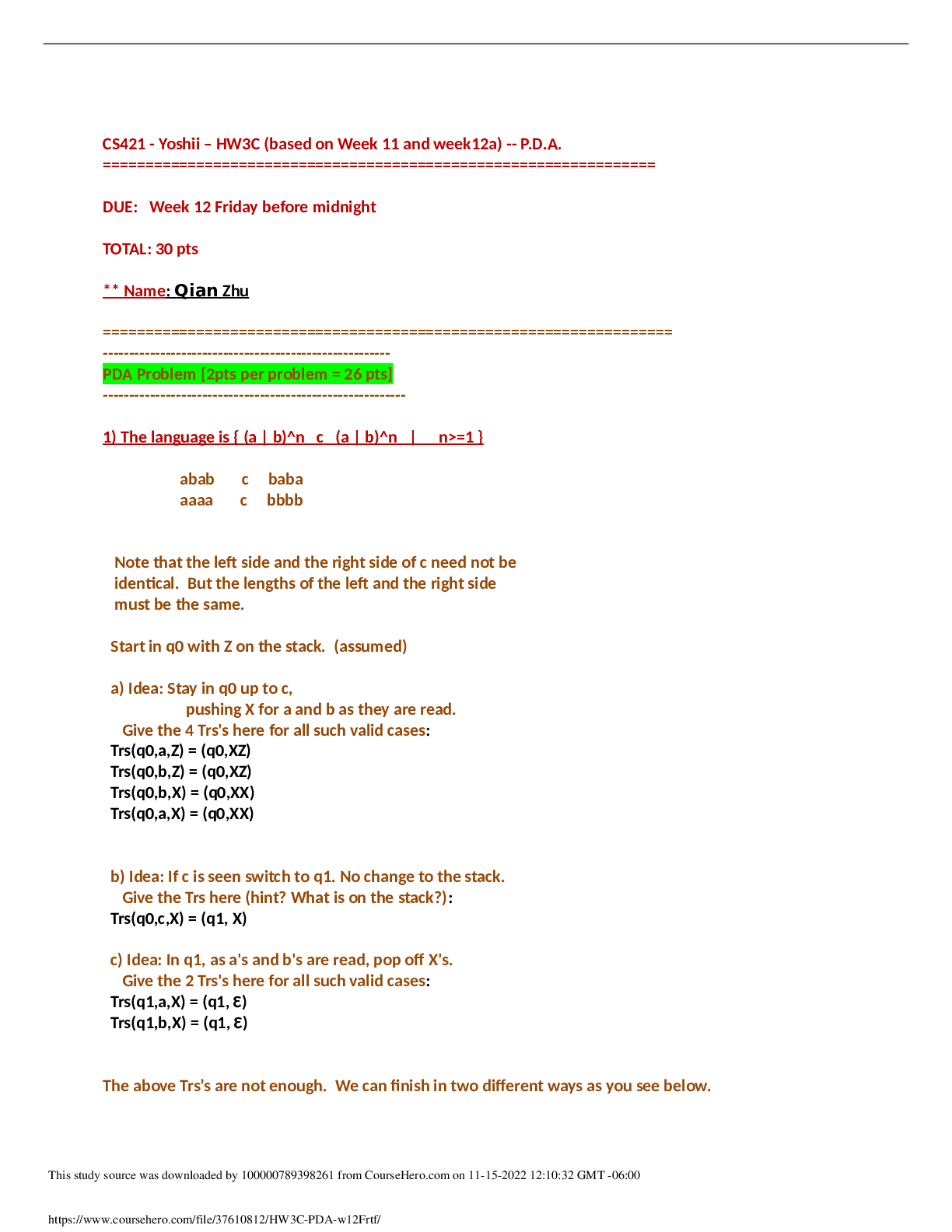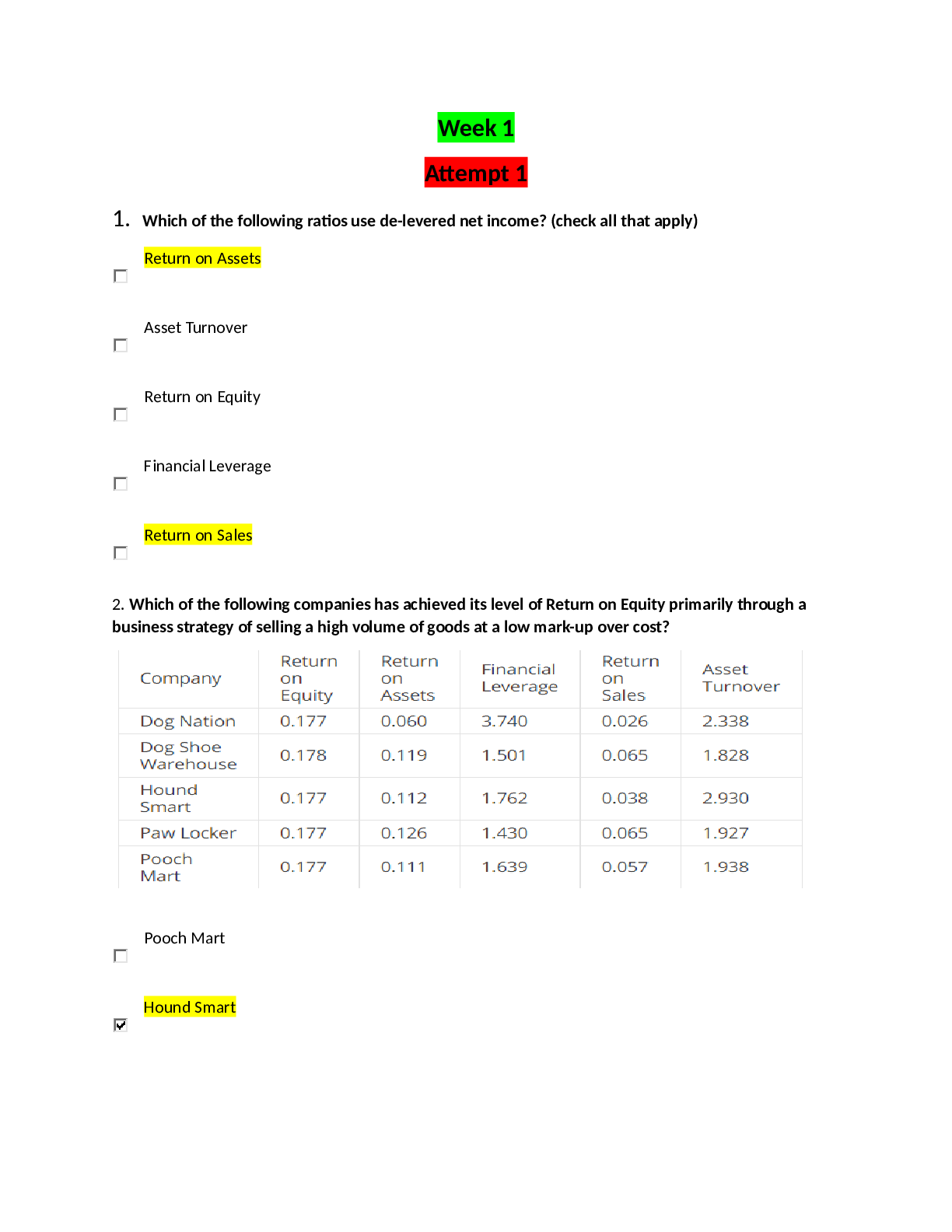Cummunity Policing > QUESTIONS & ANSWERS > CHAPTER 16: WHAT RESEARCH TELLS US AND A LOOK TO THE FUTURE. All Answers (All)
CHAPTER 16: WHAT RESEARCH TELLS US AND A LOOK TO THE FUTURE. All Answers
Document Content and Description Below
1. The NIJ’s Locally Initiated Research Partnerships in Policing usually involves partnerships between the local police department or other law enforcement agency and a. elementary schools throu... ghout the state. b. a local university. c. local community corrections. d. national crime prevention organizations such as MADD. 2. Experts in police research have made a number of recommendations to improve police–researcher coordination. Which of the following is not one of those recommendations discussed in the text? a. Law enforcement agencies should partner with only seasoned researchers to carefully design research. b. Law enforcement agencies should train their leaders in evaluating potential research to ensure their ability to identify suitable research partners and to recognize relevant research topics. c. Agencies should establish regular forums through which their own research interests and priorities are communicated. d. Law enforcement agencies should be willing to initiate research partnerships on regional, national, and local levels. 3. What organization is a think tank focusing on issues of crime and justice? a. Justice Research Association b. Police Foundation c. PERF d. SEARCH 4. ______________ isomorphism results from professionalism, with influences coming from such organizations as the Police Executive Research Forum. a. Normative b. Coercive c. Refractive d. Mimetic 5. At the heart of experimental design are the experimental and control conditions, which are a. random. b. calculated. c. intentional. d. selective. 6. Most research on community policing strategies shows ______________ effects on crime rates, drug abuse and trafficking, and fear of crime. a. overwhelmingly positive b. fairly positive and statistically significant c. only modest and statistically insignificant d. absolutely no 7. According to the text, to validate an evaluation conducted by survey, ______________ of the distributed surveys must be returned. a. at least 20% b. at least 60% c. 85% d. all 8. ______________ isomorphism occurs when an organization copies or imitates another. a. Normative b. Coercive c. Refractive d. Mimetic 9. The Police Foundation conducted the classic Kansas City Preventive Patrol Experiment, which showed that increasing or decreasing the level of routine preventive patrol—the backbone of police work—had ______________ on crime, fear of crime, or citizen satisfaction with police services. a. marked positive effect b. no appreciable effect c. a negative effect d. determined that further study was necessary to determine if there was an effect 10. The problems that have been associated with police research have been related to a. the lack of department support of the research. b. the lack of community involvement in the research. c. the current exclusionary style of conducting research by academics who are more interested in generating publications than in providing useful information for departments. d. None of the above 11. Which organization for law enforcement research is a national membership organization created by and for the states, dedicated to improving the criminal justice system through effective application of information and identification technology? a. JRSA b. Police Foundation c. PERF d. SEARCH 12. ______________ isomorphism occurs when organizations adopt something due to pressure either from the state or other organizations. a. Normative b. Coercive c. Refractive d. Mimetic 13. This organization was created in 1979 to enhance law enforcement as a profession and to improve law enforcement: a. IACP b. NOBLE c. CALEA d. PERF 14. To evaluate the effectiveness of specific community policing strategies, police departments should consider data from all of the following except: a. The health care system b. Schools c. Community surveys d. Homeless shelters 15. According to the text, contrary to conventional wisdom law enforcement is a. not open to research. b. predictable. c. unpredictable. d. open to research. 16. Predictive policing operates under the premise that a. crime is not predictable. b. criminal activity can be accurately predicted. c. crime is completely random. d. police can be given probabilistic information about where to go and who to police. 17. According to the text, all of the following are ways a law enforcement agency can use data from research except: a. To justify equipment purchases b. For grant applications c. For disciplinary decisions d. For hiring decisions 18. When departments are involved in the creation of surveys, they are more likely to use the research. This is an example of a. process research. b. action research. c. partner research. d. practical research. 19. The Action Research Model is a. a cyclical, multistep process. b. a nomination process for research topics. c. a process of development for grant-initiated research. d. the implementation process of the research. 20. Experiments in criminal justice raise ethical as well as ______________ issues. a. quality b. objectivity c. subjectivity d. privacy 21. According to the text, what do most experts believe will have the most profound impact on the collective ability of the federal, state, and local governments to protect the United States? a. Asymmetric threats b. Technological innovations c. Domestic terrorism d. Global terrorism 22. According to the text, which of these community policing tenets are of increased importance when facing budget cuts that reduce the number of officers on the street? a. Community partnerships b. Organizational transformation c. Problem solving d. All are correct. 23. One of the best models for police–researcher alliance is an action research approach. This approach was first used by Lewin in what decade? a. 1970s b. 1960s c. 1950s d. 1940s 24. Which research foundation has created a center for survey research? a. JRSA b. Police Foundation c. PERF d. SEARCH 25. According to the text, surveys can be conducted a. in person. b. on the phone. c. by mail. d. All of the above 26. Criminologist Larry Sherman proposed a new model of law enforcement called a. action policing. b. community-based policing. c. evidence-based policing. d. None of the above 27. According to the text, this research method emphasizes full participation in the research by everyone directly affected by the process and results a. partnership research. b. random assignment. c. action research. d. experimental design. 28. According to the text, this research method involves the random assignment of individuals to experimental (treatment) and control (no treatment) conditions: a. Partnership research b. Random assignment c. Action research d. Experimental design 29. Experiments in criminal justice raise what kind of issues? a. Ethical and privacy issues b. Crime rate and reduction c. Ethical and cultural d. Privacy and exploitation 30. One ethical issue raised when conducting research is a. evaluation bias by the researchers. b. high costs of research. c. denying the control group “treatment.” d. lack of transparency with the public. 31. Predictive policing involves how many stages? a. Six b. Three c. Eight d. Four 32. The predictive policing model cycle starts with a. data analysis. b. police intervention. c. data collection. d. target response. 33. Predictive policing is driven by a. data. b. community input. c. police monitor reports. d. budget. 34. A fundamental premise of predictive policing is a. crime occurs sporadically. b. crime is based on personality traits. c. crime is not randomly distributed. d. crime is completely predictable. 35. Predictive policing can be location based or _______ based. a. time b. crime c. day of the week d. person 36. Crime statistics are the only way to sufficiently evaluate the effectiveness of the community policing strategy. a. True b. False 37. Assistance in experiments in criminal justice is available through the NIJ’s Locally Initiated Research Partnerships in Policing. a. True b. False 38. Much of what is known about community policing derives from case studies of community policing practices in cities throughout the country. a. True b. False 39. A new model of law enforcement proposed in 1998 by Larry Sherman is called community-oriented policing. a. True b. False 40. Research has shed little light on the types of community policing activities in which various departments across the country are engaged. a. True b. False 41. Experiments in criminal justice raise both ethical and privacy issues. a. True b. False 42. The COPS Office has increased the number of sworn officers per capita by 3% nationwide and has also had a significant effect on the adoption of new and effective police practices. a. True b. False 43. According to the text, when reading case studies, one can have reasonable confidence about the kinds of steps taken by the police in a neighborhood to provide accessibility, improve responsiveness, and increase communication with residents. a. True b. False 44. Mimetic isomorphism occurs when an organization copies or imitates another organization. a. True b. False 45. Surveys may be used to determine what citizens believe are a neighborhood’s main problems. a. True b. False 46. According to the text, an ethical issue in police research is to deny the new processes to a “control group.” a. True b. False 47. In the NIJ’s Locally Initiated Research Partnerships in Policing, partners share responsibility throughout the entire project, jointly selecting an area of interest and collaborating on the research design, and implementation and interpretation of findings. a. True b. False 48. Globalization and the trend toward a decreasingly networked world economy will become more pronounced within the next five years. a. True b. False 49. As pointed out in the text, contrary to conventional wisdom, law enforcement agencies are actually quite open to the research process. a. True b. False 50. As stated by the authors, most experts believe that technological innovation will have the most profound impact on the collective ability of the federal, state, and local governments to protect the United States. a. True b. False 51. In reality, ______________ is more a philosophy than a model to use when confronted with an issue or problem. 52. ____________ isomorphism occurs when an organization copies or imitates another. 53. ______________ isomorphism occurs when organizations adopt something as a result of pressure either from the state or other organizations. 54. ______________ isomorphism results from professionalism, with influences coming from such organizations as PERF and IACP. 55. ______________ means “similar in structural characteristics” and results in a one-size-fits-all approach to community policing. 56. ______________ research emphasizes full participation by everyone directly affected by the process and results. 57. The effectiveness of community policing is often measured using ______________ for a given jurisdiction. 58. Experiments in criminal justice raise ______________issues as well as privacy issues. 59. Hundreds of agencies across the United States and Canada have become ______________ , and more are going through the process every year. 60. At the heart of ______________ is the random assignment of individuals to experimental and control conditions. 61. To validate an evaluation conducted by survey, ____% of distributed surveys must be returned 62. _________________ is an important way to measure crime in a community. 63. ________________________ uses an algorithm to convert crime data into crime forecasting in the same way modeling technology is used by meteorologists to predict weather events. 64. If departments want more effective approaches to evaluating community policing efforts, it is especially important to use data collected and maintained by _______________ agencies other than law enforcement agencies. 65. Illustrate and explain the Action Research Model, labeling each step. 66. What role should research play in community policing? [Show More]
Last updated: 2 years ago
Preview 1 out of 21 pages

Buy this document to get the full access instantly
Instant Download Access after purchase
Buy NowInstant download
We Accept:

Reviews( 0 )
$9.00
Can't find what you want? Try our AI powered Search
Document information
Connected school, study & course
About the document
Uploaded On
Jan 15, 2020
Number of pages
21
Written in
Additional information
This document has been written for:
Uploaded
Jan 15, 2020
Downloads
0
Views
103






.png)
.png)
.png)
.png)
.png)
.png)
.png)

